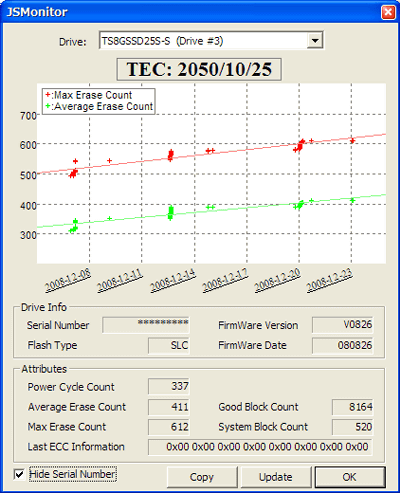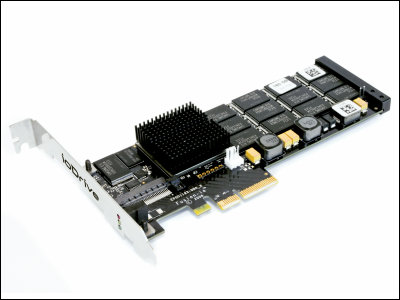"JSMonitor" free software capable of monitoring SSD and predicting lifetime

It is that life that is worrisome when purchasing SSD. At present, there are two kinds of SSD NAND flash, SLC NAND Flash (SLC: Single Level Cell) and MLC NAND Flash (MLC: Multi Level Cell), and the number of rewritable times isSLC 100,000 times, MLC only 10,000 timesIt has become. Since the data may be damaged if it exceeds the upper limit of rewrite frequency, it is easy to reach this upper limit when defragmentation is done, so it is not dangerous.
So this free software "JSMonitor", You can display the state of increase in maximum erase count (Max Erase Count) and average erase count (Average Erase Count) for each block graphically and predict the life span.
Details of the mechanism to predict life and download from the following.
Monitoring of JMF 602 equipped SSD · Lifetime prediction software "JSMonitor" released - Doctoral course graduate student escape diary
Downloading is possible from the above page, and it corresponds to SSD equipped with JMicron's JMF 602 controller. Information on the list of SSDs that confirmed the operation on the above page and the version of Windows that was able to be launched are gathered.
The startup screen looks something like this.

It is safe if "Average Erase Count" and "Max Erase Count" approach the upper limit value.

In addition, it also has useful features such as warning about how many seconds to acquire data from S.M.A.R.T., when the System Block Count changes (if a block breakage occurs).
According to the included "Readme.txt", "principle of life estimation" looks like this. Since it is natural that it can not be said that it is absolutely correct, let's use it as a guide only after considering it.
4. Principle of lifetime estimation
As is well known, there are limitations on the number of times of rewriting in NAND flash, and rewriting the number of times exceeding it may damage the NAND flash. The number of times of rewriting of the NAND flash adopted in the current SSD is about 100,000 times for SLC type and about 10,000 times for MLC type.
Life estimation of this software is performed by predicting the date when the block with the highest rewrite frequency in the SSD reaches the rewrite limit number.
"Block" is the data unit in the flash memory, and in the case of SSD it has a size of approximately 1MB to 8MB. The NAND flash performs writing (raise any bit from 0 to 1) and reading in smaller "page" units. On the other hand, in order to return (erase) the bit rising to 1 to 0, it is necessary to lower all the memory cells belonging to one block to 0. Therefore, the number of rewrites (= erase count) of the flash memory is managed in block units. This software uses S.M.A.R.T. to obtain the maximum number of erase cycles per block.
In SSD, a mechanism called wear leveling is working, and the number of times of rewriting of each block is managed to be as equal as possible. However, the more you use it in the author's environment, the bigger the difference between the maximum erase count and the average erase count is opening. For that reason, life is estimated by using the maximum number of erase times instead of the average erase count.
This software records the time and maximum erase count when the maximum erase count increases. After accumulating data to a certain extent, we obtain the increment of the maximum erase count per day using the least squares method. Then, assuming that the increase amount is kept for a long time, calculate the date when the maximum erase count exceeds the limit value.
Estimation of lifetime of this software has two assumptions. The first assumption is that the number of times of rewriting per day is (almost) constant, and the second assumption is that the number of rewrites of the flash memory is limited to 100,000 in SLC and 10,000 in MLC .
In other words, if the amount used per day is not constant, the reliability of the estimation result will decrease. Also, there is no data on how much probability the NAND flash will be damaged if it actually reaches the limit of rewriting. Keep in mind these things, please do not expect excessive expectation for estimation results.
Also, because the lifetime estimation result is "unavailable" in the initial state, it is said that "life estimation is calculated only when the maximum number of erase cycles increases three or more times". This is because why wear leveling works in SSD, so it is necessary to write the same capacity as the capacity of the drive in order to increase the maximum erase count by "1". For example, in the case of a 64 GB SSD, if about 192 GB of data is written, lifetime estimation is not performed.
Related Posts:
in Software, Posted by darkhorse







